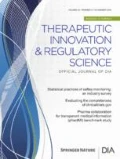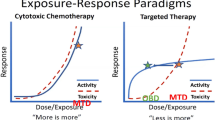Abstract
The sequencing of the human genome brings with it the hope that greater understanding of genetic components of disease will allow the more specific targeting of therapies. It has also been suggested that it will permit sponsors to run “cleaner” clinical trials with less variability and a consequent saving in patient numbers. However, we do not know how much of the variation in response that we see from patient to patient in clinical trials is genetic, because we rarely design the sort of trials that would allow us to identify patient-by-treatment interaction. Such interaction provides an upper bound for gene-by-treatment interaction for a group of patients studied since patients differ by more than their genes. On the other hand, however, the variability seen within a clinical trial may generally be expected to be less than the total variation that would be seen within a population. There is a related statistical issue to do with the interpretation of effects from clinical trials. This arises because there is confusion between experimental and sampling models of clinical research. It is concluded that we may have to pay careful attention to certain design features of clinical trials if we wish to make progress in this field.
Similar content being viewed by others
References
Sykes R. The Pharmaceutical Industry in the New Millenium: Capturing the Scientific Promise. London: Centre for Medicines Research; 1977, 1–28.
Evans WE, Relling MV. Pharmacogenomics: Translating functional genomics into rational therapeutics. Science. 1999;286:487–491.
Conover WJ, Salsburg DS. Locally most powerful tests for detecting treatment effects when only a subset of patients can be expected to respond to treatment. Biometrics. 1988;44:189–196.
Sheiner LB, Rosenberg B, Melmon KL. Modelling of individual pharmacokinetics for computer-aided drug dosage. Comput Biomed Res. 1972;5:411–459.
Hartl DL. A Primer of Population Genetics. Sunderland, MA: Sinauer Associates, Inc; 2000.
Elston RC. Introduction and overview. Stat Methods Med Res. 2000;9:527–541.
Horwitz RI, Singer BH, Makuch RW, Viscoli CM. Can treatment that is helpful on average be harmful to some patients? A study of the conflicting information needs of clinical inquiry and drug regulation [see comments). J Clin Epidemiol. 1996;49:395–400.
Gail M, Simon R. Testing for qualitative interactions between treatment effects and patient subsets. Biometrics. 1985;41:361–372.
Senn SJ, Harrell F. On wisdom after the event [comment] [see comments]. J Clin Epidemiol. 1997;50: 749–751.
Senn SJ, Harrell FE Jr. On subgroups and groping for significance [letter; comment]. J Clin Epidemiol. 1998;51:1367–1368.
Horwitz RI, Singer BH, Makuch RW, Viscoli CM. On reaching the tunnel at the end of the light [comment] [see comments]. J Clin Epidemiol. 1997;50: 753–755.
Galbraith RF. Graphical display of estimates having differing standard errors. Technometrics. 1988;30: 271–281.
Galbraith RF. A note on graphical presentation of estimated odds ratios from several clinical-trials. Stat Med. 1988;7:889–894.
Galbraith RF. Some applications of radial plots. J Am Stat Assoc. 1994;89:1232–1242.
Hardy RJ, Thompson SG. A likelihood approach to meta-analysis with random effects. Stat Med. 1996; 15:619–629.
Senn SJ. Statistical Issues in Drug Development. Chichester: John Wiley; 1997.
Guyatt GH, Juniper EF, Walter SD, Griffith LE, Goldstein RS. Interpreting treatment effects in ran-domised trials [see comments]. Br Med J. 1998;316: 690–693.
Hutton JL. Numbers needed to treat: properties and problems (with comments). J Roy Stat Society A. 2000;163:403–419.
Smeeth L, Haines A, Ebrahim S. Numbers needed to treat derived from meta-analyses—sometimes informative, usually misleading [see comments]. Br Med J. 1999;318:1548–1551.
Senn SJ. Applying results of randomised trials to patients. N of 1 trials are needed [letter; comment]. Br Med J. 1998;317:537–538.
Cox DR, Fitzpatrick R, Fletcher AE, Gore SM, Spiegelhalter DJ, Jones DR. Quality-of-life assessment—Can we keep it simple. J R Stat Soc Ser A-Stat Soc. 1992;155:353–393.
March L, Irwig L, Schwarz J, Simpson J, Chock C, Brooks P. n of 1 trials comparing a non-steroidal anti-inflammatory drug with paracetamol in osteoarthritis. Br Med J. 1994;309:1041–1045; discussion 1045-1046.
Senn SJ. Suspended judgment n-of-1 trials. Control Clin Trials. 1993;14:1–5.
Senn SJ, Bakshi R, Ezzet N. n of 1 trials in osteoarthritis. Caution in interpretation needed [letter; comment]. Br Med J. 1995;310:667.
Shumaker RC, Metzlcr, CM. The phenytoin trial is a case study of “individual bioequivalence.” Drug Inf J. 1998;32:1063–1072.
Kieser M, Hauschke D. Statistical method for demonstrating equivalence in crossover trials based on the ratio of two location parameters. Drug Inf J. 2000;34:563–568.
Senn SJ. In the blood: proposed new requirements for registering generic drugs. Lancet. 1998;352:85–86.
Kane GC, Lipsky JJ. Drug-grapefruit juice interactions. Mayo Clin Proc. 2000;75:933–942.
Kalow W, Tang BK, Endrenyi L. Hypothesis: comparisons of inter- and intra-individual variations can substitute for twin studies in drug research. Pharmacogenetics. 1998;8:283–289.
Kalow W, Ozdemir V, Tang BK, Tothfalusi L, Endrenyi L. The science of pharmacological variability: an essay. Clin Pharmacol Ther. 1999;66:445–447.
Ozdemir V, Kalowa W. Tang BK, Paterson AD, Walker SE, Endrenyi L, Kashuba AD. Evaluation of the genetic component of variability in CYP3A4 activity: a repeated drug administration method. Pharmacogenetics. 2000;10:373–388.
Senn SJ. Crossover Design. In: Encyclopedia of Bio-pharmaceutical Statistics. SC Chow and JP Liu, eds. New York: Marcel Dekker; 2000, 142–149.
Senn SJ. Cross-over trials. In: Encyclopedia in Bio-statistics., P Armitage and T Colton, eds. New York: Wiley; 1998, 1033–1049.
Senn SJ. Cross-over Trials in Clinical Research. Chichester: John Wiley; 1993.
Meinert CL, Gilpin AK, Unalp A, Dawson C. Gender representation in trials. Control Clin Trials. 2000;21:462–475.
Rom DM, Hwang E. Testing for individual and population equivalence based on the proportion of similar responses [see comments]. Stat Med. 1996:15:1489–1505.
Senn SJ. Testing for individual and population equivalence based on the proportion of similar responses [letter; comment]. Stat Med. 1997;16:1303–1306.
Hauck WW, Hyslop T, Anderson S. Generalized treatment effects for clinical trials. Slat Med. 2000; 19:887–899.
Chen M, Kianifard F. A nonparametric procedure associated with a clinically meaningful efficacy measure. Biostatistics. 2000;1:293–298.
Glass, GE. Primary, secondary and meta-analysis of research. Educat Research. 1976;5:3–8.
Rosenbaum PR, Rubin DR. The central role of the propensity score in observational studies for causal effect. Biometrika. 1983;70:41–55.
Rubin DB. Estimating causal effects of treatment in randomized and nonrandomized studies. J Educat Psychol. 1974;66:688–701.
Meyer UA. Pharmacogenetics and adverse drug reactions. Lancet. 2000;356.
Guo X, Rotimi C, Cooper R, Luke A, Elston RC, Ogunbiyi O, Ward R. Evidence of a major gene effect for angiotensinogen among Nigerians. Ann Hum Genet. 1999;63:293–300.
Author information
Authors and Affiliations
Corresponding author
Rights and permissions
About this article
Cite this article
Senn, S. Individual Therapy: New Dawn or False Dawn?. Ther Innov Regul Sci 35, 1479–1494 (2001). https://doi.org/10.1177/009286150103500443
Published:
Issue Date:
DOI: https://doi.org/10.1177/009286150103500443




